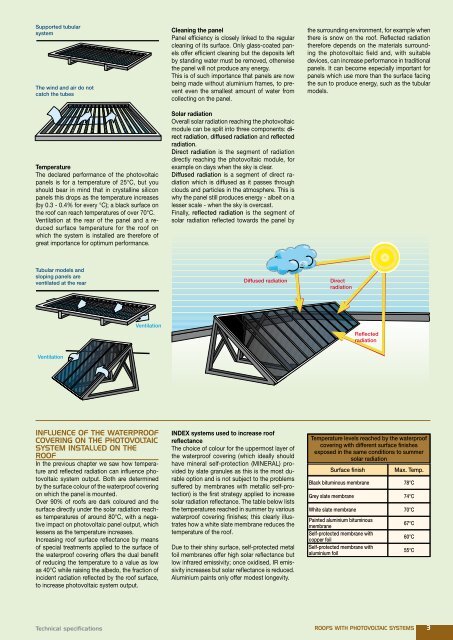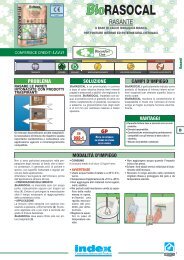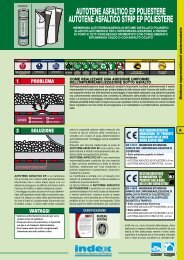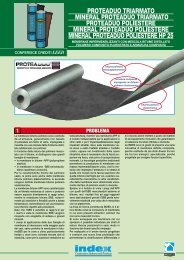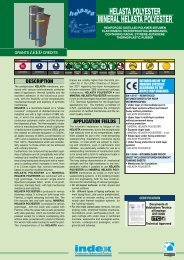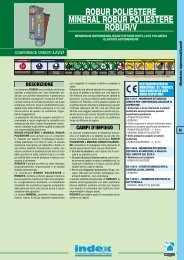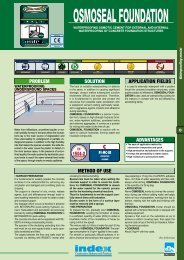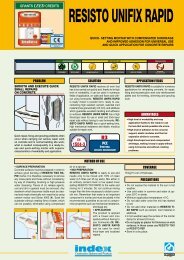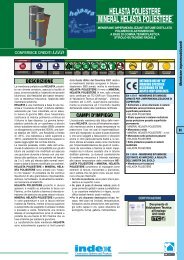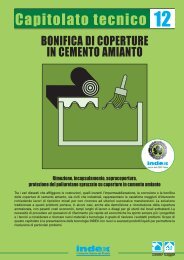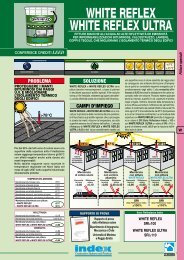INTRODUCTIONThe architecture used in sustainable buildingis not limited to the design of a “conserving”shell in terms of energy: current design researchis intended to make the building shellperform an “active” energy role through theapplication of solar energy collectors and photovoltaicsystems for solar energy production.The European Directive promoting the use ofrenewable energy sources (Directive 2001/77/EC), assimilated in Italy through Law Decree387 of 2003 and followed up by subsequentimplementation regulations, introduced ContoEnergia, a working account scheme incentivisingthe production of electricity using solarenergy from photovoltaic systems connectedto the electricity mains on a permanent basis.Italy is one of the sunniest European countries,especially in the Southern regions, butits photovoltaic industry is one of the leastdeveloped in the world.It is estimated that in Italy, using current technology,a photovoltaic system is capable ofgenerating approximately 1150 kWh per yearfor each kWp of photovoltaic modules installed,a value which gradually rises to 1500kWh as you move southwards. Germany, inspite of its less favourable geographical position,is particularly advanced in its productionof electricity from solar energy; however, foreach kWp of photovoltaic modules installed,just 600 kWh/kWp is produced per year.Italy's favourable climatic situation allows thebeneficiary to recoup all outlay costs withinthe space of ten years, and to make approximatelythe same amount in the following tenyears. In the south, the situation improveseven further, as the investment tends to berepaid within approximately 8 years. Roofs ontop of buildings, especially non-walkable flatroofs with a visible waterproof covering, areGBC ITALIA (Green Building Council)AND LEED CERTIFICATIONGBC Italia, to which INDEXbelongs, has the task of usingthe guidelines commonto everyone in the LEEDinternational community todevelop the characteristicsof the LEED Italia sys-member of GBC Italiatem, which must take intoconsideration the specific climatic, buildingand legislative conditions in Italy.LEED opts for a view of sustainability by makingthe most of all opportunities to reduce thevarious kinds of environmental impacts andharmful emissions of the buildings being built.The LEED (Leadership in Energy andEnvironmental Design) standards are parametersfor sustainable building developed in theUSA and applied in 40 countries throughoutthe world. They indicate the requirementsfor eco-compatible buildings, able to “work”sustainably and self-sufficiently energy-wise. Itis essentially a rating system for the developmentof “green” buildings.LEED is a certification, which may be obtainedon a voluntary basis, where the designer actuallydeals with collecting data for the assessment.The system is based on the awardof credits for each of the requirements thatcharacterise the sustainability of the building.The certification level achieved comes fromthe sum of the credits.unused surfaces which could conveniently beutilised for the production of electricity fromsolar energy by means of a photovoltaic solarThe assessment criteria used by LEED (2009version) are grouped into six categories (+1only valid in the USA), which envisage one ormore compulsory prerequisites and a numberof environmental performances that conributeto the building’s final score:• Sustainable sites(1 prerequisite, 26 points)• Efficient water consumption(1 prerequisite, 10 points)• Energy and atmosphere(3 prerequisites, 35 points)• Materials and resources(1 prerequisite, 14 points)• Indoor environmental quality(2 prerequisites, 15 points)• Innovation and design process (6 points)• Regional priority (4 points) only applicablein the USAThere are 4 rating levels:• Certified: between 40 and 49 points• Silver: between 50 and 59 points• Gold: between 60 and 79 points• Platinum: more than 80 pointsThe following point in the LEED regulationsincludes the solar reflectance index:• SS Credit 7.2: Heat Island Effect - RoofSRI (solar reflectance index) limits of the roofingmaterialspanel system, in compliance with sustainablebuilding criteria.USEFUL INFORMATIONREGARDING <strong>PHOTOVOLTAIC</strong>PANELS INSTALLED ON A ROOFOrientation and slopeThe ideal orientation and slope for photovoltaicpanels is facing south, at approx. 30°; however,satisfactory results can also be achieved withsouth-east and south-west facing panels, atsloping angles of 20° and 40°.On a flat surface, output is reduced by approximately10% in relation to the figure achievedusing the ideal slope.System withdirected modulesSystem with flat,rigid modulesOutput and surfacesPhotovoltaic panels currently on the marketuse various technologies, offering differentperformance levels. Using high-output modulesto achieve a given power value only requires asmall surface area, saving space and makingit easier to position the panels in the sunniestareas on the roof, avoiding shady spots.The mass per unit area of a photovoltaicsystemThe weight per square metre of the photovoltaicsystem is particularly important; it must bealigned with the extra load capacity of the roof.The load not only depends on the unit weightof the panel, but also on the roof installationmethod used.The impact of panels secured by means of aballast (in order to avoid puncturing the waterproofcovering) is linked to the amount of windin the area and the geometry of the roof, and isgreater than the impact of systems which aremechanically fixed to the support (the averageweight is 40-50 kg/m 2 ).However, innovative tubular photovoltaic modulesare available which do not require ballastsor fixings; these can withstand winds of around208 km/h and weigh 16 kg/m 2 .Ballasted systemSystem fixedmechanicallySystem with supportedinterlocking modules2 <strong>ROOFS</strong> <strong>WITH</strong> <strong>PHOTOVOLTAIC</strong> <strong>SYSTEMS</strong> Technical specifications
Supported tubularsystemThe wind and air do notcatch the tubesTemperatureThe declared performance of the photovoltaicpanels is for a temperature of 25°C, but youshould bear in mind that in crystalline siliconpanels this drops as the temperature increases(by 0.3 - 0.4% for every °C); a black surface onthe roof can reach temperatures of over 70°C.Ventilation at the rear of the panel and a reducedsurface temperature for the roof onwhich the system is installed are therefore ofgreat importance for optimum performance.Cleaning the panelPanel efficiency is closely linked to the regularcleaning of its surface. Only glass-coated panelsoffer efficient cleaning but the deposits leftby standing water must be removed, otherwisethe panel will not produce any energy.This is of such importance that panels are nowbeing made without aluminium frames, to preventeven the smallest amount of water fromcollecting on the panel.Solar radiationOverall solar radiation reaching the photovoltaicmodule can be split into three components: directradiation, diffused radiation and reflectedradiation.Direct radiation is the segment of radiationdirectly reaching the photovoltaic module, forexample on days when the sky is clear.Diffused radiation is a segment of direct radiationwhich is diffused as it passes throughclouds and particles in the atmosphere. This iswhy the panel still produces energy - albeit on alesser scale - when the sky is overcast.Finally, reflected radiation is the segment ofsolar radiation reflected towards the panel bythe surrounding environment, for example whenthere is snow on the roof. Reflected radiationtherefore depends on the materials surroundingthe photovoltaic field and, with suitabledevices, can increase performance in traditionalpanels. It can become especially important forpanels which use more than the surface facingthe sun to produce energy, such as the tubularmodels.Tubular models andsloping panels areventilated at the rearDiffused radiationDirectradiationVentilationReflectedradiationVentilationINFLUENCE OF THE WATERPROOFCOVERING ON THE <strong>PHOTOVOLTAIC</strong>SYSTEM INSTALLED ON THEROOFIn the previous chapter we saw how temperatureand reflected radiation can influence photovoltaicsystem output. Both are determinedby the surface colour of the waterproof coveringon which the panel is mounted.Over 90% of roofs are dark coloured and thesurface directly under the solar radiation reachestemperatures of around 80°C, with a negativeimpact on photovoltaic panel output, whichlessens as the temperature increases.Increasing roof surface reflectance by meansof special treatments applied to the surface ofthe waterproof covering offers the dual benefitof reducing the temperature to a value as lowas 40°C while raising the albedo, the fraction ofincident radiation reflected by the roof surface,to increase photovoltaic system output.INDEX systems used to increase roofreflectanceThe choice of colour for the uppermost layer ofthe waterproof covering (which ideally shouldhave mineral self-protection (MINERAL) providedby slate granules as this is the most durableoption and is not subject to the problemssuffered by membranes with metallic self-protection)is the first strategy applied to increasesolar radiation reflectance. The table below liststhe temperatures reached in summer by variouswaterproof covering finishes; this clearly illustrateshow a white slate membrane reduces thetemperature of the roof.Due to their shiny surface, self-protected metalfoil membranes offer high solar reflectance butlow infrared emissivity; once oxidised, IR emissivityincreases but solar reflectance is reduced.Aluminium paints only offer modest longevity.Temperature levels reached by the waterproofcovering with different surface finishesexposed in the same conditions to summersolar radiationSurface finishBlack bituminous membraneGrey slate membraneWhite slate membranePainted aluminium bituminousmembraneSelf-protected membrane withcopper foilSelf-protected membrane withaluminium foilMax. Temp.78°C74°C70°C67°C60°C55°CTechnical specifications<strong>ROOFS</strong> <strong>WITH</strong> <strong>PHOTOVOLTAIC</strong> <strong>SYSTEMS</strong>3


